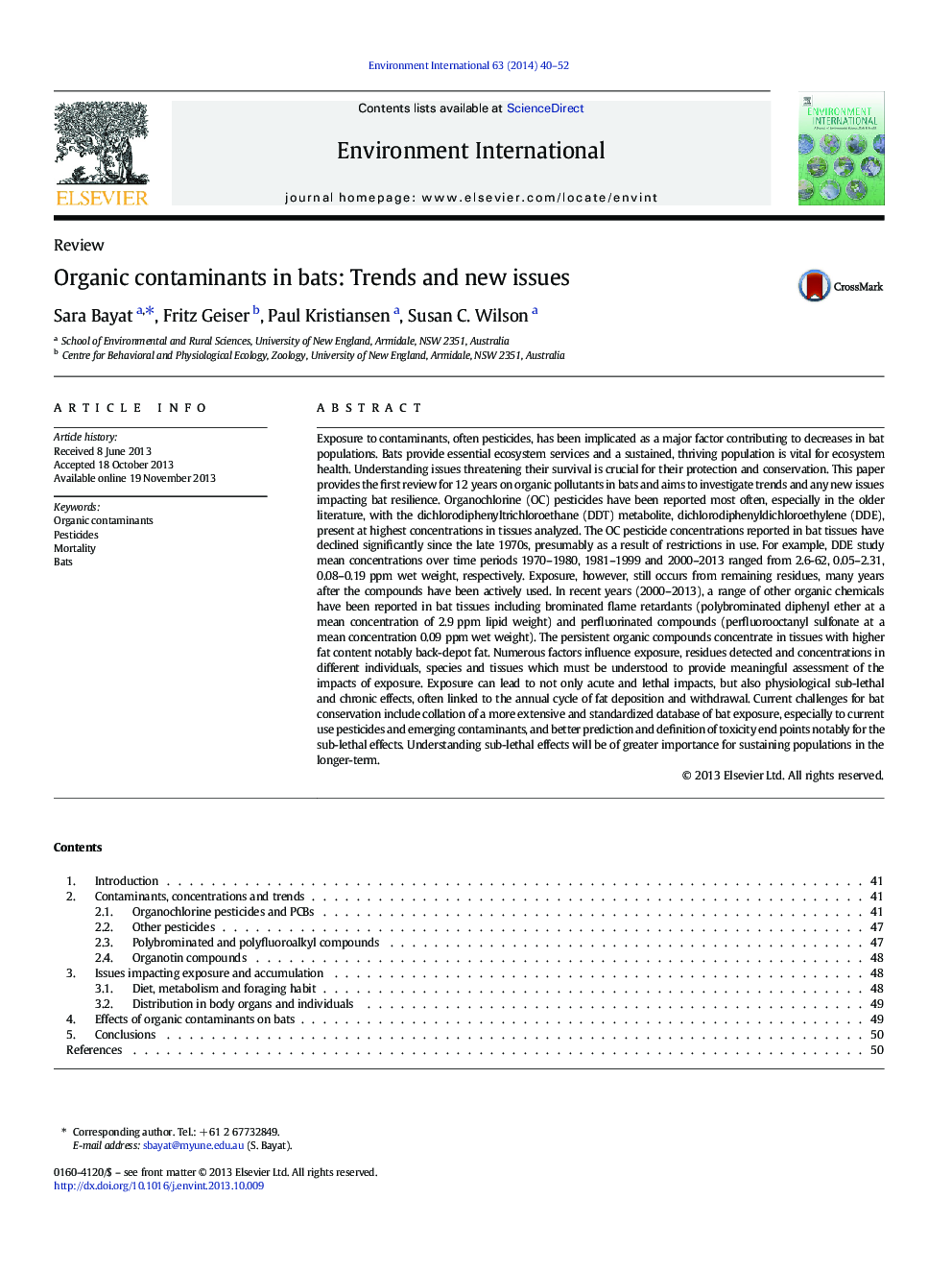| کد مقاله | کد نشریه | سال انتشار | مقاله انگلیسی | نسخه تمام متن |
|---|---|---|---|---|
| 6314057 | 1619065 | 2014 | 13 صفحه PDF | دانلود رایگان |
عنوان انگلیسی مقاله ISI
Organic contaminants in bats: Trends and new issues
ترجمه فارسی عنوان
آلاینده های آلی در خفاش ها: روند و مسائل جدید
دانلود مقاله + سفارش ترجمه
دانلود مقاله ISI انگلیسی
رایگان برای ایرانیان
کلمات کلیدی
آلاینده های آلی، آفت کش ها، مرگ و میر خفاش ها،
موضوعات مرتبط
علوم زیستی و بیوفناوری
علوم محیط زیست
شیمی زیست محیطی
چکیده انگلیسی
Exposure to contaminants, often pesticides, has been implicated as a major factor contributing to decreases in bat populations. Bats provide essential ecosystem services and a sustained, thriving population is vital for ecosystem health. Understanding issues threatening their survival is crucial for their protection and conservation. This paper provides the first review for 12Â years on organic pollutants in bats and aims to investigate trends and any new issues impacting bat resilience. Organochlorine (OC) pesticides have been reported most often, especially in the older literature, with the dichlorodiphenyltrichloroethane (DDT) metabolite, dichlorodiphenyldichloroethylene (DDE), present at highest concentrations in tissues analyzed. The OC pesticide concentrations reported in bat tissues have declined significantly since the late 1970s, presumably as a result of restrictions in use. For example, DDE study mean concentrations over time periods 1970-1980, 1981-1999 and 2000-2013 ranged from 2.6-62, 0.05-2.31, 0.08-0.19Â ppm wet weight, respectively. Exposure, however, still occurs from remaining residues, many years after the compounds have been actively used. In recent years (2000-2013), a range of other organic chemicals have been reported in bat tissues including brominated flame retardants (polybrominated diphenyl ether at a mean concentration of 2.9Â ppm lipid weight) and perfluorinated compounds (perfluorooctanyl sulfonate at a mean concentration 0.09Â ppm wet weight). The persistent organic compounds concentrate in tissues with higher fat content notably back-depot fat. Numerous factors influence exposure, residues detected and concentrations in different individuals, species and tissues which must be understood to provide meaningful assessment of the impacts of exposure. Exposure can lead to not only acute and lethal impacts, but also physiological sub-lethal and chronic effects, often linked to the annual cycle of fat deposition and withdrawal. Current challenges for bat conservation include collation of a more extensive and standardized database of bat exposure, especially to current use pesticides and emerging contaminants, and better prediction and definition of toxicity end points notably for the sub-lethal effects. Understanding sub-lethal effects will be of greater importance for sustaining populations in the longer-term.
ناشر
Database: Elsevier - ScienceDirect (ساینس دایرکت)
Journal: Environment International - Volume 63, February 2014, Pages 40-52
Journal: Environment International - Volume 63, February 2014, Pages 40-52
نویسندگان
Sara Bayat, Fritz Geiser, Paul Kristiansen, Susan C. Wilson,
